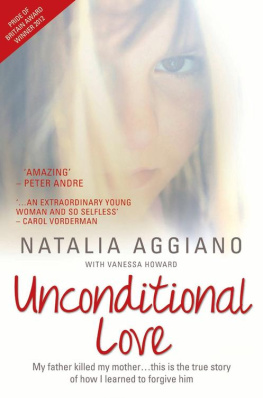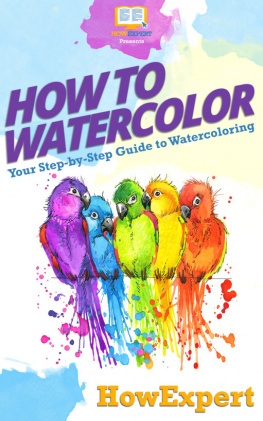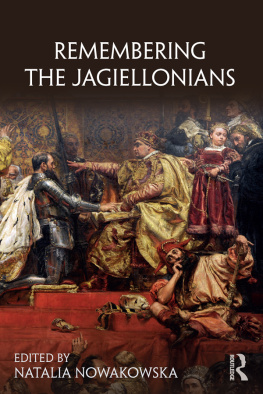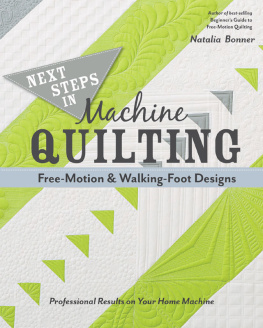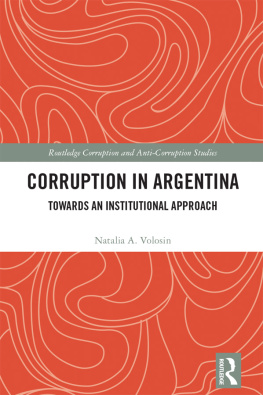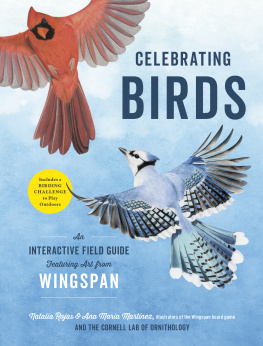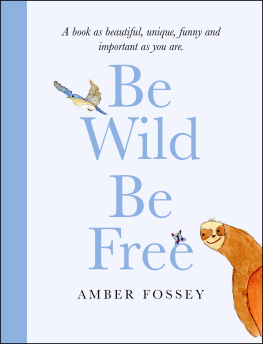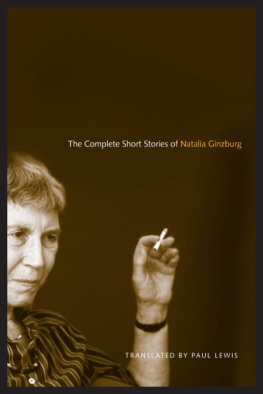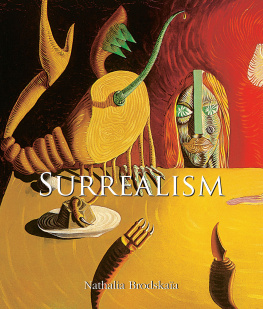Natalia Skatula - Watercolor Wild and Free
Here you can read online Natalia Skatula - Watercolor Wild and Free full text of the book (entire story) in english for free. Download pdf and epub, get meaning, cover and reviews about this ebook. publisher: David & Charles, genre: Home and family. Description of the work, (preface) as well as reviews are available. Best literature library LitArk.com created for fans of good reading and offers a wide selection of genres:
Romance novel
Science fiction
Adventure
Detective
Science
History
Home and family
Prose
Art
Politics
Computer
Non-fiction
Religion
Business
Children
Humor
Choose a favorite category and find really read worthwhile books. Enjoy immersion in the world of imagination, feel the emotions of the characters or learn something new for yourself, make an fascinating discovery.
- Book:Watercolor Wild and Free
- Author:
- Publisher:David & Charles
- Genre:
- Rating:3 / 5
- Favourites:Add to favourites
- Your mark:
- 60
- 1
- 2
- 3
- 4
- 5
Watercolor Wild and Free: summary, description and annotation
We offer to read an annotation, description, summary or preface (depends on what the author of the book "Watercolor Wild and Free" wrote himself). If you haven't found the necessary information about the book — write in the comments, we will try to find it.
Watercolor Wild and Free — read online for free the complete book (whole text) full work
Below is the text of the book, divided by pages. System saving the place of the last page read, allows you to conveniently read the book "Watercolor Wild and Free" online for free, without having to search again every time where you left off. Put a bookmark, and you can go to the page where you finished reading at any time.
Font size:
Interval:
Bookmark:

WILD & FREE
Natalia Skatula

www.davidandcharles.com
How lovely to see you holding this book full of brightly colored and mindful watercolor inspirations in your hands. Creating beautiful things on paper is one of my favorite pastimes. Like many others, I am often left feeling tense and stressed by the ups and downs of work and life in general. But painting gives me peace and tranquility. I see it as a form of mindfulness that brightens up my everyday life, and thats what Id like to share with you in this book.
I hope that the pages of this book will inspire you to bring your own creative ideas to life in many ways. And dont be afraid of the blank page inspiration is everywhere. You just have to pay attention to what is around you.
Yours,
I post little clips from my everyday creativity on my Instagram account @nataskalia.
Before you set about your first project, take a little time to have a brief look at watercolor painting. This section will give you useful information about how to get started and what to do about pencils, brushes, paints,and paper. Its only by having a good understanding of the materials you will be working with, and their functions and capabilities, that you will achieve the results and effects you are looking for.
Watercolor painting is a very exciting and sometimes unpredictable technique. It is possible to paint with great precision and detail with watercolors, but they can also be used to produce spontaneous color sequences that are pleasingly imperfect. Depending on how much water you use, the water-soluble paint will run rapidly in different directions over the paper, producing totally unplanned and unique splashes of color. This is precisely what is so fascinating for me with my watercolor work the interaction of the random patterns of color and small detailed touches, from which a finished picture emerges.
When you make your initial sketches, never copy your reference picture in exact detail. Its much more about creating small new worlds of color, allowing the interaction of water and color to take its course and seeing what comes out of it.
It doesnt matter whether its a bear wearing a hat or a sloth hanging in the vines the main thing is that were plunging into a world of form and color that makes us happy and enriches our everyday lives with creative inspiration.
Getting started with watercolor does not require a lot of equipment. You will normally only need:
- pencil
- eraser
- brushes
- paper
- watercolors
- absorbent cloth or paper towel
- glass water container

Considering the wide selection available and the differences in price, finding the right brush may seem daunting, but it does not have to be. Natural hair brushes are normally more expensive than synthetic ones. Your brush should essentially be capable of absorbing water well and holding it. It should be flexible and regain its shape after each brushstroke. It is also important that the fibers do not crumple up after the brush has been used for dabbing splashes of paint or drawing lines. There are basically two types of brush round and flat. A round brush, where the fibers form a point, can be used to produce both fine and broad strokes, depending on how you apply the brush to the paper. This also applies to flat brushes, which are particularly suitable for larger areas such as backgrounds. Some of my favorites are the Cosmotop Spin series of round and flat brushes from da Vinci, which are very soft and dont fray easily. Three or four brushes, ranging from fine to broad, should be enough to get you started on various projects. I recommend round brushes in size nos. 0, 3, 5 and 8 or 10.
Clean your brushes regularly under running water. This will keep them in good condition and ensure they last for a long time.
Choosing the right paper is extremely important. Above all it must be absorbent. The various types of paper are distinguished by their grain size, which in turn depends on the texture of the paper, and by the paper thickness, which is stated in grams per square meter. Lightly grained paper has a smooth surface, whereas coarse-grained paper is rough. Every type of paper has its advantages, so you should try them out for yourself. Coarse paper is obviously more structured, producing a color effect that is different from the more detailed work you can easily achieve on fine or smooth paper. The thicker the watercolor paper is, the easier it is to paint on, as it is more absorbent and less likely to curl up or lose its shape.
I like working with Hahnemhle Britannia watercolor paper, which has a density of 300g/m in matt. This paper is about 200g/m heavier than normal drawing paper, where the normal weight is 100150g/m. It is extremely absorbent and robust, and it allows me to do any kind of watercolor painting, whether its delicate, detailed, or broadly expressive.
Watercolor pads that are glued on all four edges work extremely well, because the paper does not curl up when you are using a lot of water. Carefully separate the paper with a knife or ruler once the painting is dry.
Youll need a pencil for your sketches. Its best to use an HB pencil for this as it will give you a fine but clear line thats easy to erase.
A soft rubber eraser is recommended as it is the least likely to damage the surface structure of the paper when used. I like using the Faber-Castell kneadable eraser.

An old cloth or some paper towel can be worth its weight in gold. For one thing, you can always wipe your brush on it. And whats more, it helps you deal with minor accidents or disasters. If, for example, you have applied too much paint to a surface, you can easily dab it off or wipe it away with a cloth.
A clean brush is also good for wiping away unwanted paint.
Watercolors vary in quality and come in various forms, for example in pans or tubes. Single watercolors in tubes are more concentrated than the hard paint in pans. The latter has to be moistened with a wet brush before you start in order to release the paint, which is then automatically diluted. Whichever you choose is a matter of taste.
I used Schmincke watercolors in pans for the projects in this book. A small box of watercolors with a medium range of colors is enough to get started. Other colors can easily be mixed from the basic colors.
A few simple exercises can help you become more confident with the materials youre working with. Try out brushes and paints on different types of paper. You will soon see how your materials react under different conditions and how much this can affect the results.
Font size:
Interval:
Bookmark:
Similar books «Watercolor Wild and Free»
Look at similar books to Watercolor Wild and Free. We have selected literature similar in name and meaning in the hope of providing readers with more options to find new, interesting, not yet read works.
Discussion, reviews of the book Watercolor Wild and Free and just readers' own opinions. Leave your comments, write what you think about the work, its meaning or the main characters. Specify what exactly you liked and what you didn't like, and why you think so.


